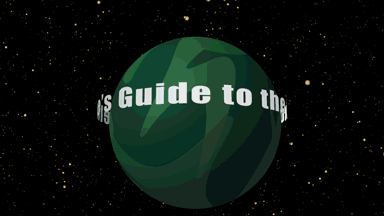Scienceline’s Guide to the Exoplanets: The Cosmic Ray Diamond
PSR J1719-1438 b: Barely clinging onto glimmering traces of life
Rahul Rao • March 30, 2020

Your favorite planets, and you didn't even know they existed. [Credit: Curtis Segarra | CC BY-NC-ND 2.0]
PSR J1719-1438 b: The Cosmic Ray Diamond
Discovered by: Matthew Bailes, et al
Discovered: 2011
Distance from Earth: ~1200 parsecs (~3900 light-years)
Size: ~4 Earth radii
Mass: ~1 Jupiter mass
Surface climate: Monsoon rains of ionizing radiation
Habitability for humans: Maybe for mutants
When Jocelyn Bell Burnell and Anthony Hewish discovered the first known pulsar in 1967, they were so baffled by what they’d found — a spectacularly strong signal, ticking like clockwork at such a perfect pace — they genuinely thought they might have found proof of aliens.
Pulsars are entirely natural. They can result when massive stars reach the end of their lives and go supernova. While the most massive stars collapse into black holes, their slightly lighter counterparts instead become neutron stars: remnant cores so dense that normal matter collapses into clumps of subatomic particles. Neutron stars with strong magnetic fields become pulsars, shooting twin jets of radiation out in opposing directions, like a celestial lighthouse.
And since pulsars rotate at regular intervals, the spinning of those jets keeps some of the most perfect time we know — even more accurate than atomic clocks. If pulsars have planets that even marginally disrupt that incessant ticking, we can detect them. There’s a handful of known exoplanets that have been discovered around pulsars, and PSR J1719-1438 b is one of them.
PSR J1719-1438 b orbits its host pulsar at just 0.004 AU — less than half a million miles. If it were in our solar system, it would orbit within the Sun’s surface. Furthermore, its pulsar rotates through a full spin every 5.8 milliseconds — meaning that, hundreds of times in each second, PSR J1719-1438 b is bombarded with an ion storm of sterilizing radiation.
If you’re wondering where planets orbiting pulsars actually come from, scientists have several hypotheses. Some pulsar planets might be wandering rogue planets that fell into the pulsar’s orbit; other pulsars have been shown to have rings of dust around them, which could in turn form planets.
PSR J1719-1438 b may have formed through a third method. Scientists believe it was once a star in its own right, perhaps a binary partner, a companion in the same system. But when its main star went supernova, PSR J1719-1438 b’s outer layers were blasted away. Therefore, the PSR J1719-1438 b we’re seeing now is a remnant core that’s been left behind, still caught around its main star.
Scientists also believe that PSR J1719-1438 b has oxygen at its surface. That’s where any similarity to Earth — or, for that matter, any planet in our solar system — ends. Underneath, the planet is very dense: the mass of Jupiter, squished down to a world not much larger than Earth. The high density suggests that the planet lacks the hydrogen and helium found in most gas giants.
Instead, it’s likely that the oxygen gives way to carbon as you go deeper into the planet — and the high pressures and extreme environment mean that the carbon has crystallized, forming something like diamond.
If you’re expecting to outfit an expedition to go mine this planet and get rich, however, remember what it is you’re actually coming within less than half a million miles of, and kindly rethink your plans.